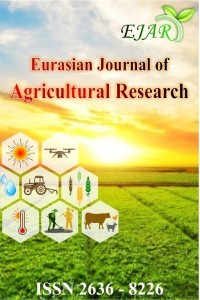Detecting the Chemical Changes of Sugar Beet by Using Remote Sensing Technology
Detecting the Chemical Changes of Sugar Beet by Using Remote Sensing Technology
The changes in spectral behavior of plants against chemical effects were investigated by using remote sensing and its terrestrial spectral data, in this study. Sugar beet plant was selected as test plants. Study area was splitted into 3 sections for the sugar beet plant and three different phosphorus fertilization were treated to this sections (300 kg P ha-1, 150 kg P ha-1 and 0 kg P ha-1). Terrestrial spectral measurements were carried out on the leaves of the sugar beets, after the development of them. The reflectance values obtained by terrestrial spectral measurement data were used as an end member in order to run spectral classification and Sentinel 2A satellite image was used for spectral classification. Vegetation indices also were produced in order to support the spectral classification results. As a result of the study, remote sensing and its terrestrial components' usability have been shown in order to prevent wrong fertilization, to increase product yield, to protect the health of the plant and soil.
___
- Birdal A. C., Avdan U. & Türk T. 2017. Estimating Tree Heights with İmages from an Unmanned Aerial Vehicle, Geomatics Natural Hazards and Risk, 8(2), 1144-1156.
- Canbaz O., Gürsoy Ö. & Gökçe A. 2017. Determination of Hydrothermal Alteration Areas by Aster Satellite Images: Ağmaşat Plato- Zara (Sivas) / Turkey Sample, Cumhuriyet Science Journal, 38(3), 419-426.
- Canbaz O., Gürsoy Ö. & Gökçe A. 2018. Detecting Clay Minerals in Hydrothermal Alteration Areas with Integration of ASTER Image and Spectral Data in Kösedag-Zara (Sivas), Turkey, Journal of the Geological Society of India, 91(4), 483-488.
- Clevers J. G. P. W. & Gitelson A. A. 2013. Remote Estimation of Crop and Grass Chlorophyll and Nitrogen Content Using Red-Edge Bands on Sentinel-2 And -3, International Journal of Applied Earth Observation and Geoinformation, 23, 344-351.
- Clevers J. G. P. W. & Kooistra L. 2012. Using Hyperspectral Remote Sensing Data for Retrieving Canopy Chlorophyll and Nitrogen Content, IEEE Journal of Selected Topics in Applied Earth Observations and Remote Sensing, 5(2), 574-583.
- Gandhi M. G., Parthiban S., Thummalu N. & Christy A. 2015. Ndvi: Vegetation Change Detection Using Remote Sensing and Gis – A Case Study of Vellore District, Procedia Computer Science, 57, 1199-1210.
- Gibson P. J. 2000. Introductory Remote Sensing: Principles and Concepts, 2 Park Square, Milton Park, Abingdon, Oxon, OX14 4RN, 176s, Abingdon, USA.
- Gürsoy Ö. & Kaya Ş. 2016. Detecting Of Lithological Units by Using Terrestrial Spectral Data and Remote Sensing Image, Journal of the Indian Society of Remote Sensing, 45 (2), 1-11.
- Gürsoy Ö., Demirbaş A., Atun R. & Durukan H. 2017. Farklı Dozlarda Zn Ve Cd Uygulamalarının Şekerpancarının Spektral Imzasına Etkisinin Belirlenmesi, Tufuab Ix.Teknik Sempozyumu, 9, 144-147.
- Gürsoy Ö., Canbaz O., Gökçe A. & Atun R. 2017. Spectral Classification in Lithological Mapping; A Case Study of Matched Filtering, Cumhuriyet Science Journal, 38(4), 731-737.
- Gürsoy Ö. & Atun R. 2018. Comparison of Spectral Classification Methods in Water Quality, Cumhuriyet Science Journal, 39(2), 543-549.
- Gürsoy Ö. & Atun R. 2019a. The Investigation of Surface Water Pollution by Integrated Remotely Sensed and Field Spectral Measurement Data of Kızılırmak: A Case Study, Polish Journal of Environmental Studies, 28(4), 1-6.
- Gürsoy Ö. & Atun R. 2019b. Using Remote Sensing in Detecting Sugar Beet Fields Treated with Different Doses of Phosphorus, Fresenius Environmental Bulletin, 28(2A), 1247-1253.
- Harsanyi J. C. & Chang C. I. 1994. Hyperspectral Image Classification and Dimensionality Reduction: An Orthogonal Subspace Projection Approach, IEEE Transactions on Geoscience and Remote Sensing, 32(4), 779-785.
- He L., Zhang H. Y. Zhang Y. S., Song X., Feng W., Kang G. Z., Wang C. Y. & Guo T.C. 2016. Estimation Canopy Leaf Nitrogen Concentration in Winter Wheat Based On Multiangular Hyperspectral Remote Sensing, European Journal of Agronomy, 73, 170-185.
- Özelkan E., Karaman M., Candar S., Coşkun Z. & Örmeci C., 2015. Investigation of Grapevine Photosynthesis Using Hyperspectral Techniques and Development of Hyperspectral Band Ratio Indices Sensitive to Photosynthesis, Journal of Environmental Biology, 36, 91-100.
- Peng Y., Gitelson A. A., Keydan G., Rundquist D. C. & Moses W., 2011. Remote Estimation of Gross Primary Production in Maize and Support for a New Paradigm Based on Total Crop Chlorophyll Content, Remote Sensing of Environment, 115, 978-989.
- Ramoelo A., Dzikiti S., Deventer H. V., Maherry A., Cho M. A. & Gush M. 2015. Potential to Monitor Plant Stress Using Remote Sensing Tools, Journal of Arid Environments, 113, 134-144.
- Rouse J. W., Haas R. H., Schell J. A. & Deering D.W. 1974. Monitoring Vegetation Systems in the Great Plains with ERTS, NASA SP-351, Third ERTS-1 Symposium NASA, 3, 309-317.
- Vina A., Gitelson A. A., Robertson A. N. L. & Peng Y. 2011. Comparison of Different Vegetation Indices for the Remote Assessment of Green Leaf Area Index of Crops, Remote Sensing of Environment, 115, 3468-3478.
- Welmann T., Haase D., Knapp S., Salbach C., Selsam P. & Lausch A. 2018. Urban Land Use Intensity Assessment: The Potential of Spatio-Temporal Spectral Traits with Remote Sensing, Ecological Indicators, 85, 190-203.
- Yousfi S., Kellas N., Saidi L., Benlakehal Z., Chaou L., Siad D., Herda F., Karrou M., Vergara O., Gracia A., Araus J. L. & Serret M. D. 2016. Comparative Performance of Remote Sensing Methods in Assessing Wheat Performance under Mediterranean Conditions, Agricultural Water Management, 164(1), 137-147.
- ISSN: 2636-8226
- Yayın Aralığı: Yılda 2 Sayı
- Başlangıç: 2017
- Yayıncı: Muhammed Cüneyt BAĞDATLI
Sayıdaki Diğer Makaleler
NPK Contents of Vermicast as Influenced by Varying Substrates
Christian Ulysses CAGASAN, Malvin DATAN, Warren Kim SİAROT
Investigation of the Lagged Effects of Livestock Supports on the Animal Production Value in Turkey
significance of cryopreservation biotechnology for protection of aquatic species
Advantages of Using the Biofertilizers in Ukrainian Agroecosystems
Hasrat ARJJUMEND, Konstantia KOUTOUKİ, Olga DONETS
Detecting the Chemical Changes of Sugar Beet by Using Remote Sensing Technology
